HRM201 - Analyzing HRM Challenges in a Rapidly Changing Business
VerifiedAdded on 2023/06/11
|9
|2137
|214
Essay
AI Summary
This essay analyzes the challenges faced by Human Resource Management (HRM) due to the rapidly transforming business landscape. It identifies four chief challenges: change management, leadership development, measurement of HR effectiveness, and workforce diversity. The essay discusses the impact of these challenges on organizations, such as employee resistance to change, difficulty in recruiting effective leaders, lack of proper measurement tools, and conflicts arising from cultural diversity. For each challenge, the essay provides recommendations for HR professionals, including maintaining transparency during change, investing in leadership training, developing modern HR measurement tools, and promoting cultural understanding among employees. The essay concludes that organizations should invest in their HR departments to address these challenges effectively and ensure future success. Desklib provides access to similar essays and solved assignments for students.
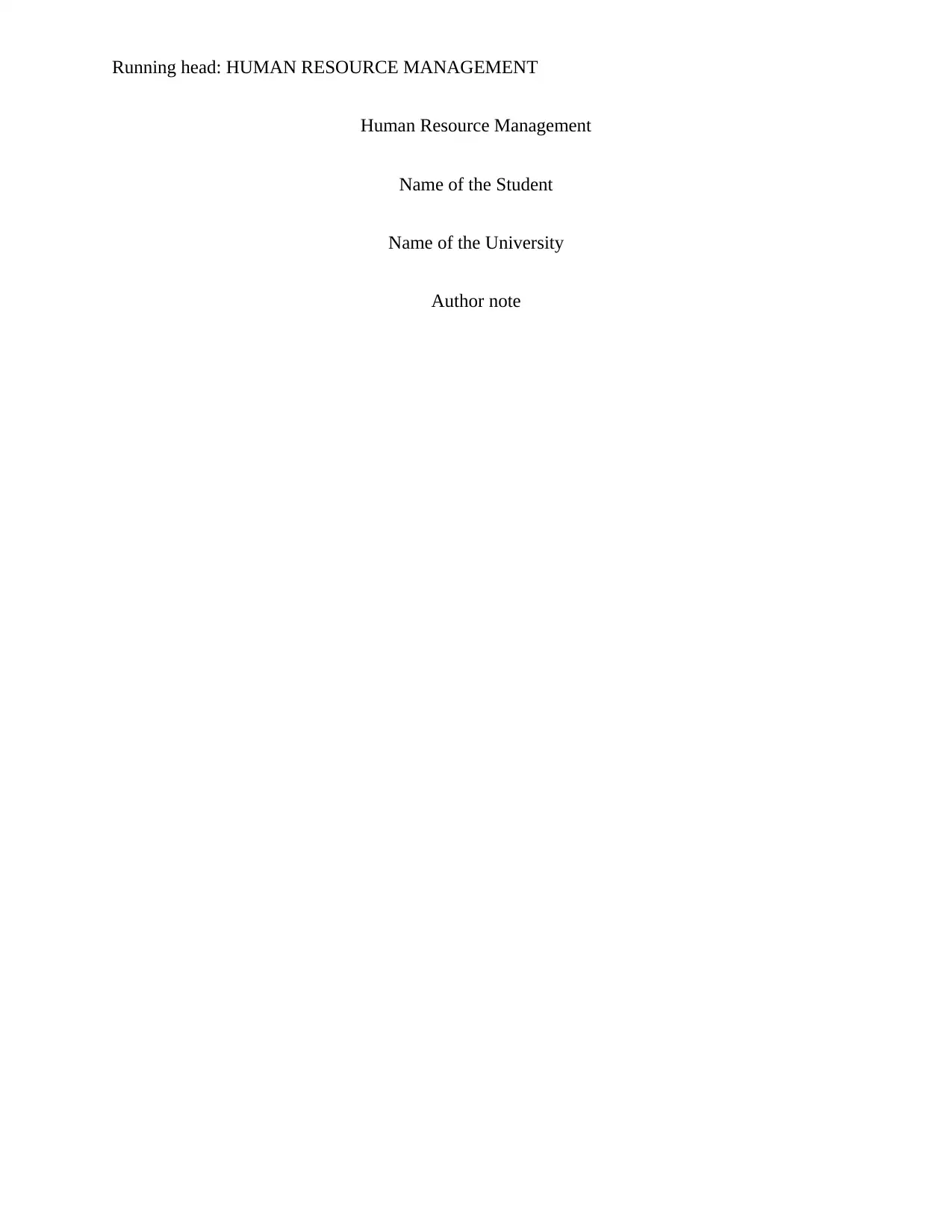
Running head: HUMAN RESOURCE MANAGEMENT
Human Resource Management
Name of the Student
Name of the University
Author note
Human Resource Management
Name of the Student
Name of the University
Author note
Paraphrase This Document
Need a fresh take? Get an instant paraphrase of this document with our AI Paraphraser
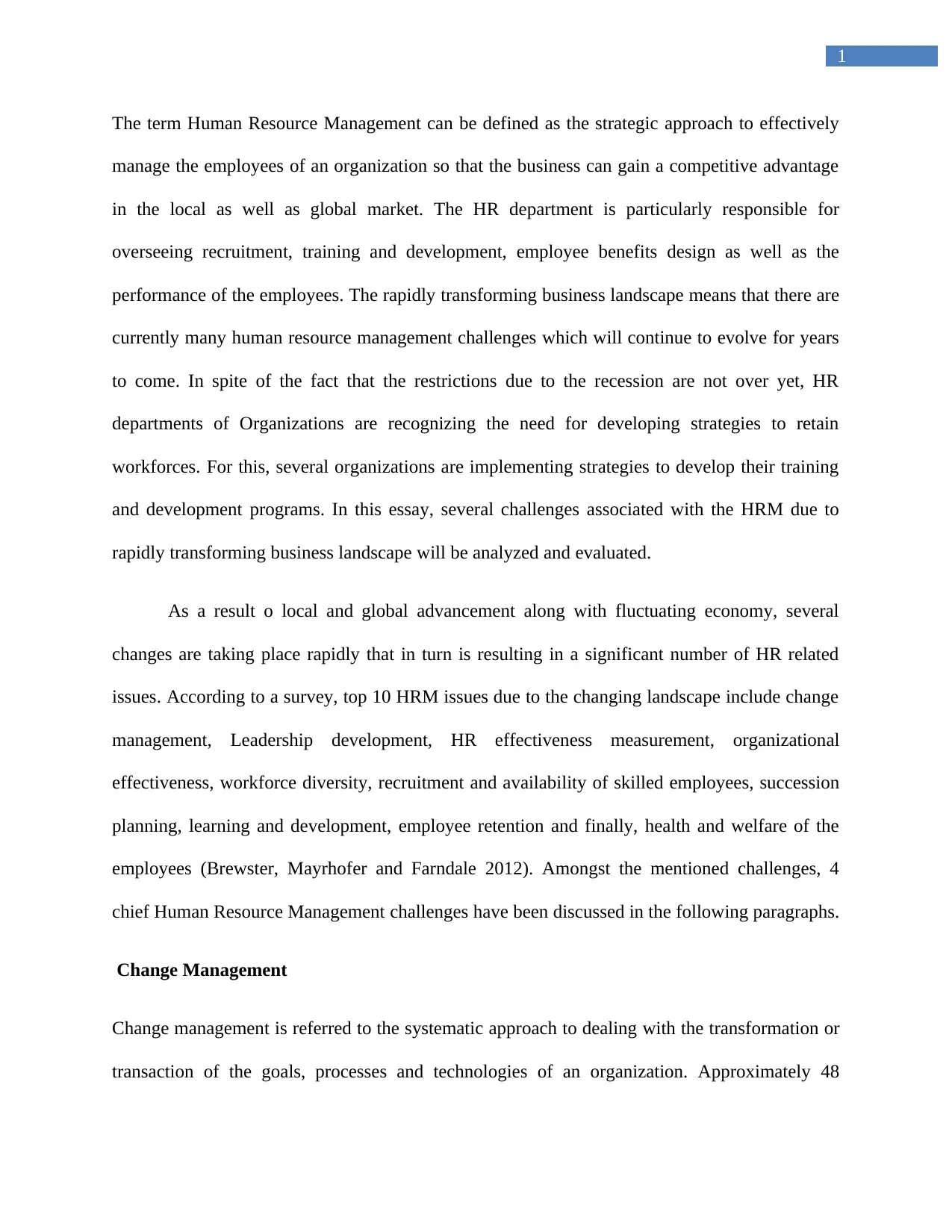
1
The term Human Resource Management can be defined as the strategic approach to effectively
manage the employees of an organization so that the business can gain a competitive advantage
in the local as well as global market. The HR department is particularly responsible for
overseeing recruitment, training and development, employee benefits design as well as the
performance of the employees. The rapidly transforming business landscape means that there are
currently many human resource management challenges which will continue to evolve for years
to come. In spite of the fact that the restrictions due to the recession are not over yet, HR
departments of Organizations are recognizing the need for developing strategies to retain
workforces. For this, several organizations are implementing strategies to develop their training
and development programs. In this essay, several challenges associated with the HRM due to
rapidly transforming business landscape will be analyzed and evaluated.
As a result o local and global advancement along with fluctuating economy, several
changes are taking place rapidly that in turn is resulting in a significant number of HR related
issues. According to a survey, top 10 HRM issues due to the changing landscape include change
management, Leadership development, HR effectiveness measurement, organizational
effectiveness, workforce diversity, recruitment and availability of skilled employees, succession
planning, learning and development, employee retention and finally, health and welfare of the
employees (Brewster, Mayrhofer and Farndale 2012). Amongst the mentioned challenges, 4
chief Human Resource Management challenges have been discussed in the following paragraphs.
Change Management
Change management is referred to the systematic approach to dealing with the transformation or
transaction of the goals, processes and technologies of an organization. Approximately 48
The term Human Resource Management can be defined as the strategic approach to effectively
manage the employees of an organization so that the business can gain a competitive advantage
in the local as well as global market. The HR department is particularly responsible for
overseeing recruitment, training and development, employee benefits design as well as the
performance of the employees. The rapidly transforming business landscape means that there are
currently many human resource management challenges which will continue to evolve for years
to come. In spite of the fact that the restrictions due to the recession are not over yet, HR
departments of Organizations are recognizing the need for developing strategies to retain
workforces. For this, several organizations are implementing strategies to develop their training
and development programs. In this essay, several challenges associated with the HRM due to
rapidly transforming business landscape will be analyzed and evaluated.
As a result o local and global advancement along with fluctuating economy, several
changes are taking place rapidly that in turn is resulting in a significant number of HR related
issues. According to a survey, top 10 HRM issues due to the changing landscape include change
management, Leadership development, HR effectiveness measurement, organizational
effectiveness, workforce diversity, recruitment and availability of skilled employees, succession
planning, learning and development, employee retention and finally, health and welfare of the
employees (Brewster, Mayrhofer and Farndale 2012). Amongst the mentioned challenges, 4
chief Human Resource Management challenges have been discussed in the following paragraphs.
Change Management
Change management is referred to the systematic approach to dealing with the transformation or
transaction of the goals, processes and technologies of an organization. Approximately 48
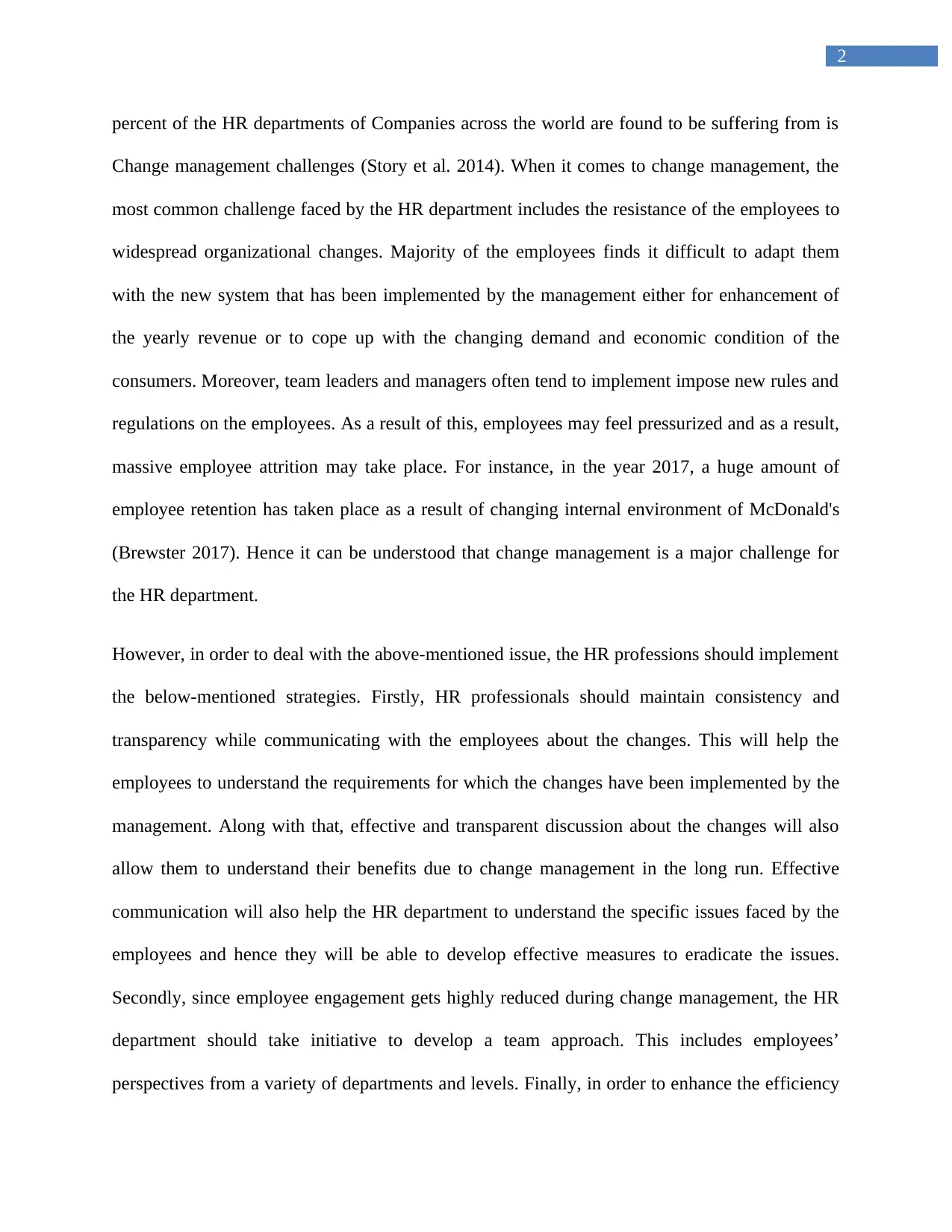
2
percent of the HR departments of Companies across the world are found to be suffering from is
Change management challenges (Story et al. 2014). When it comes to change management, the
most common challenge faced by the HR department includes the resistance of the employees to
widespread organizational changes. Majority of the employees finds it difficult to adapt them
with the new system that has been implemented by the management either for enhancement of
the yearly revenue or to cope up with the changing demand and economic condition of the
consumers. Moreover, team leaders and managers often tend to implement impose new rules and
regulations on the employees. As a result of this, employees may feel pressurized and as a result,
massive employee attrition may take place. For instance, in the year 2017, a huge amount of
employee retention has taken place as a result of changing internal environment of McDonald's
(Brewster 2017). Hence it can be understood that change management is a major challenge for
the HR department.
However, in order to deal with the above-mentioned issue, the HR professions should implement
the below-mentioned strategies. Firstly, HR professionals should maintain consistency and
transparency while communicating with the employees about the changes. This will help the
employees to understand the requirements for which the changes have been implemented by the
management. Along with that, effective and transparent discussion about the changes will also
allow them to understand their benefits due to change management in the long run. Effective
communication will also help the HR department to understand the specific issues faced by the
employees and hence they will be able to develop effective measures to eradicate the issues.
Secondly, since employee engagement gets highly reduced during change management, the HR
department should take initiative to develop a team approach. This includes employees’
perspectives from a variety of departments and levels. Finally, in order to enhance the efficiency
percent of the HR departments of Companies across the world are found to be suffering from is
Change management challenges (Story et al. 2014). When it comes to change management, the
most common challenge faced by the HR department includes the resistance of the employees to
widespread organizational changes. Majority of the employees finds it difficult to adapt them
with the new system that has been implemented by the management either for enhancement of
the yearly revenue or to cope up with the changing demand and economic condition of the
consumers. Moreover, team leaders and managers often tend to implement impose new rules and
regulations on the employees. As a result of this, employees may feel pressurized and as a result,
massive employee attrition may take place. For instance, in the year 2017, a huge amount of
employee retention has taken place as a result of changing internal environment of McDonald's
(Brewster 2017). Hence it can be understood that change management is a major challenge for
the HR department.
However, in order to deal with the above-mentioned issue, the HR professions should implement
the below-mentioned strategies. Firstly, HR professionals should maintain consistency and
transparency while communicating with the employees about the changes. This will help the
employees to understand the requirements for which the changes have been implemented by the
management. Along with that, effective and transparent discussion about the changes will also
allow them to understand their benefits due to change management in the long run. Effective
communication will also help the HR department to understand the specific issues faced by the
employees and hence they will be able to develop effective measures to eradicate the issues.
Secondly, since employee engagement gets highly reduced during change management, the HR
department should take initiative to develop a team approach. This includes employees’
perspectives from a variety of departments and levels. Finally, in order to enhance the efficiency
⊘ This is a preview!⊘
Do you want full access?
Subscribe today to unlock all pages.

Trusted by 1+ million students worldwide
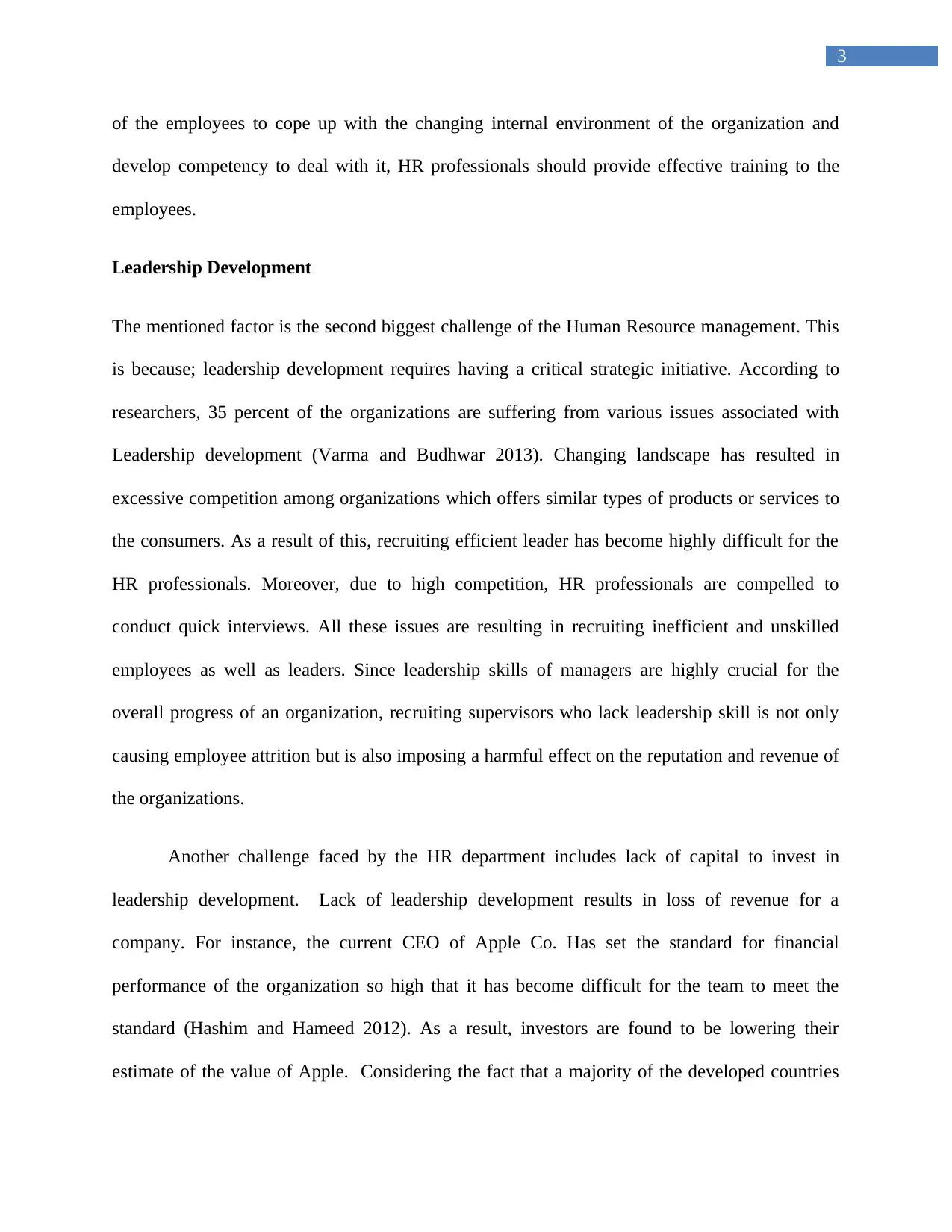
3
of the employees to cope up with the changing internal environment of the organization and
develop competency to deal with it, HR professionals should provide effective training to the
employees.
Leadership Development
The mentioned factor is the second biggest challenge of the Human Resource management. This
is because; leadership development requires having a critical strategic initiative. According to
researchers, 35 percent of the organizations are suffering from various issues associated with
Leadership development (Varma and Budhwar 2013). Changing landscape has resulted in
excessive competition among organizations which offers similar types of products or services to
the consumers. As a result of this, recruiting efficient leader has become highly difficult for the
HR professionals. Moreover, due to high competition, HR professionals are compelled to
conduct quick interviews. All these issues are resulting in recruiting inefficient and unskilled
employees as well as leaders. Since leadership skills of managers are highly crucial for the
overall progress of an organization, recruiting supervisors who lack leadership skill is not only
causing employee attrition but is also imposing a harmful effect on the reputation and revenue of
the organizations.
Another challenge faced by the HR department includes lack of capital to invest in
leadership development. Lack of leadership development results in loss of revenue for a
company. For instance, the current CEO of Apple Co. Has set the standard for financial
performance of the organization so high that it has become difficult for the team to meet the
standard (Hashim and Hameed 2012). As a result, investors are found to be lowering their
estimate of the value of Apple. Considering the fact that a majority of the developed countries
of the employees to cope up with the changing internal environment of the organization and
develop competency to deal with it, HR professionals should provide effective training to the
employees.
Leadership Development
The mentioned factor is the second biggest challenge of the Human Resource management. This
is because; leadership development requires having a critical strategic initiative. According to
researchers, 35 percent of the organizations are suffering from various issues associated with
Leadership development (Varma and Budhwar 2013). Changing landscape has resulted in
excessive competition among organizations which offers similar types of products or services to
the consumers. As a result of this, recruiting efficient leader has become highly difficult for the
HR professionals. Moreover, due to high competition, HR professionals are compelled to
conduct quick interviews. All these issues are resulting in recruiting inefficient and unskilled
employees as well as leaders. Since leadership skills of managers are highly crucial for the
overall progress of an organization, recruiting supervisors who lack leadership skill is not only
causing employee attrition but is also imposing a harmful effect on the reputation and revenue of
the organizations.
Another challenge faced by the HR department includes lack of capital to invest in
leadership development. Lack of leadership development results in loss of revenue for a
company. For instance, the current CEO of Apple Co. Has set the standard for financial
performance of the organization so high that it has become difficult for the team to meet the
standard (Hashim and Hameed 2012). As a result, investors are found to be lowering their
estimate of the value of Apple. Considering the fact that a majority of the developed countries
Paraphrase This Document
Need a fresh take? Get an instant paraphrase of this document with our AI Paraphraser
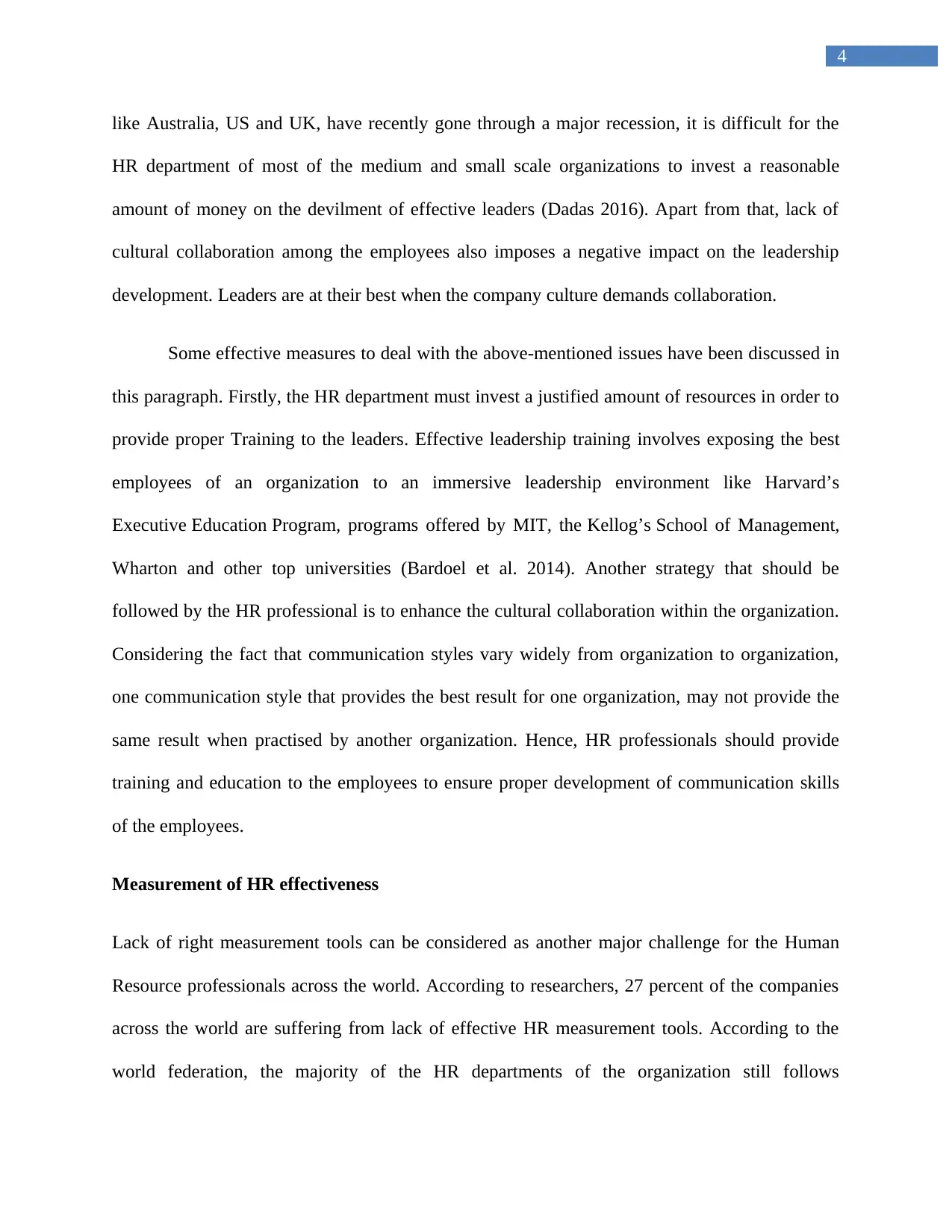
4
like Australia, US and UK, have recently gone through a major recession, it is difficult for the
HR department of most of the medium and small scale organizations to invest a reasonable
amount of money on the devilment of effective leaders (Dadas 2016). Apart from that, lack of
cultural collaboration among the employees also imposes a negative impact on the leadership
development. Leaders are at their best when the company culture demands collaboration.
Some effective measures to deal with the above-mentioned issues have been discussed in
this paragraph. Firstly, the HR department must invest a justified amount of resources in order to
provide proper Training to the leaders. Effective leadership training involves exposing the best
employees of an organization to an immersive leadership environment like Harvard’s
Executive Education Program, programs offered by MIT, the Kellog’s School of Management,
Wharton and other top universities (Bardoel et al. 2014). Another strategy that should be
followed by the HR professional is to enhance the cultural collaboration within the organization.
Considering the fact that communication styles vary widely from organization to organization,
one communication style that provides the best result for one organization, may not provide the
same result when practised by another organization. Hence, HR professionals should provide
training and education to the employees to ensure proper development of communication skills
of the employees.
Measurement of HR effectiveness
Lack of right measurement tools can be considered as another major challenge for the Human
Resource professionals across the world. According to researchers, 27 percent of the companies
across the world are suffering from lack of effective HR measurement tools. According to the
world federation, the majority of the HR departments of the organization still follows
like Australia, US and UK, have recently gone through a major recession, it is difficult for the
HR department of most of the medium and small scale organizations to invest a reasonable
amount of money on the devilment of effective leaders (Dadas 2016). Apart from that, lack of
cultural collaboration among the employees also imposes a negative impact on the leadership
development. Leaders are at their best when the company culture demands collaboration.
Some effective measures to deal with the above-mentioned issues have been discussed in
this paragraph. Firstly, the HR department must invest a justified amount of resources in order to
provide proper Training to the leaders. Effective leadership training involves exposing the best
employees of an organization to an immersive leadership environment like Harvard’s
Executive Education Program, programs offered by MIT, the Kellog’s School of Management,
Wharton and other top universities (Bardoel et al. 2014). Another strategy that should be
followed by the HR professional is to enhance the cultural collaboration within the organization.
Considering the fact that communication styles vary widely from organization to organization,
one communication style that provides the best result for one organization, may not provide the
same result when practised by another organization. Hence, HR professionals should provide
training and education to the employees to ensure proper development of communication skills
of the employees.
Measurement of HR effectiveness
Lack of right measurement tools can be considered as another major challenge for the Human
Resource professionals across the world. According to researchers, 27 percent of the companies
across the world are suffering from lack of effective HR measurement tools. According to the
world federation, the majority of the HR departments of the organization still follows
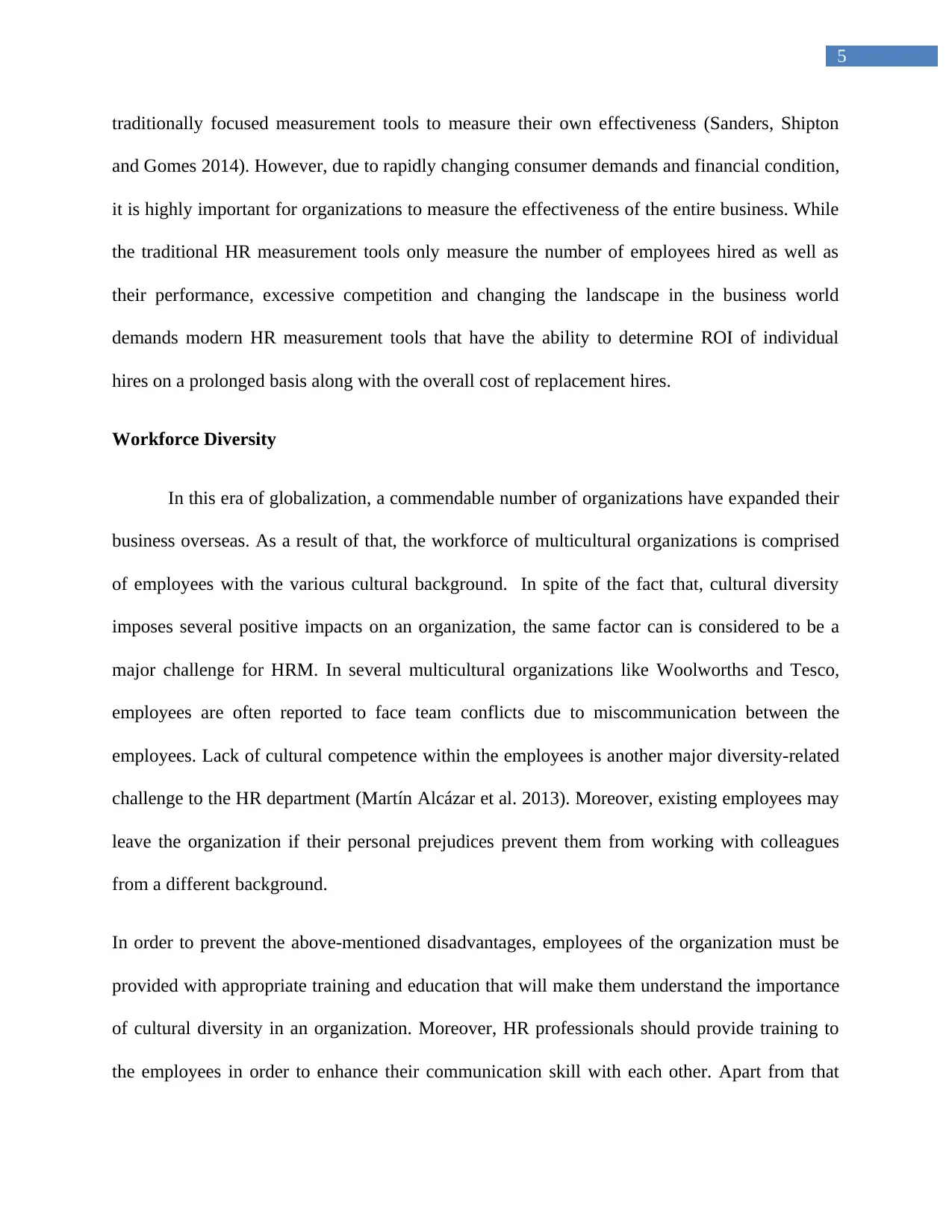
5
traditionally focused measurement tools to measure their own effectiveness (Sanders, Shipton
and Gomes 2014). However, due to rapidly changing consumer demands and financial condition,
it is highly important for organizations to measure the effectiveness of the entire business. While
the traditional HR measurement tools only measure the number of employees hired as well as
their performance, excessive competition and changing the landscape in the business world
demands modern HR measurement tools that have the ability to determine ROI of individual
hires on a prolonged basis along with the overall cost of replacement hires.
Workforce Diversity
In this era of globalization, a commendable number of organizations have expanded their
business overseas. As a result of that, the workforce of multicultural organizations is comprised
of employees with the various cultural background. In spite of the fact that, cultural diversity
imposes several positive impacts on an organization, the same factor can is considered to be a
major challenge for HRM. In several multicultural organizations like Woolworths and Tesco,
employees are often reported to face team conflicts due to miscommunication between the
employees. Lack of cultural competence within the employees is another major diversity-related
challenge to the HR department (Martín Alcázar et al. 2013). Moreover, existing employees may
leave the organization if their personal prejudices prevent them from working with colleagues
from a different background.
In order to prevent the above-mentioned disadvantages, employees of the organization must be
provided with appropriate training and education that will make them understand the importance
of cultural diversity in an organization. Moreover, HR professionals should provide training to
the employees in order to enhance their communication skill with each other. Apart from that
traditionally focused measurement tools to measure their own effectiveness (Sanders, Shipton
and Gomes 2014). However, due to rapidly changing consumer demands and financial condition,
it is highly important for organizations to measure the effectiveness of the entire business. While
the traditional HR measurement tools only measure the number of employees hired as well as
their performance, excessive competition and changing the landscape in the business world
demands modern HR measurement tools that have the ability to determine ROI of individual
hires on a prolonged basis along with the overall cost of replacement hires.
Workforce Diversity
In this era of globalization, a commendable number of organizations have expanded their
business overseas. As a result of that, the workforce of multicultural organizations is comprised
of employees with the various cultural background. In spite of the fact that, cultural diversity
imposes several positive impacts on an organization, the same factor can is considered to be a
major challenge for HRM. In several multicultural organizations like Woolworths and Tesco,
employees are often reported to face team conflicts due to miscommunication between the
employees. Lack of cultural competence within the employees is another major diversity-related
challenge to the HR department (Martín Alcázar et al. 2013). Moreover, existing employees may
leave the organization if their personal prejudices prevent them from working with colleagues
from a different background.
In order to prevent the above-mentioned disadvantages, employees of the organization must be
provided with appropriate training and education that will make them understand the importance
of cultural diversity in an organization. Moreover, HR professionals should provide training to
the employees in order to enhance their communication skill with each other. Apart from that
⊘ This is a preview!⊘
Do you want full access?
Subscribe today to unlock all pages.

Trusted by 1+ million students worldwide
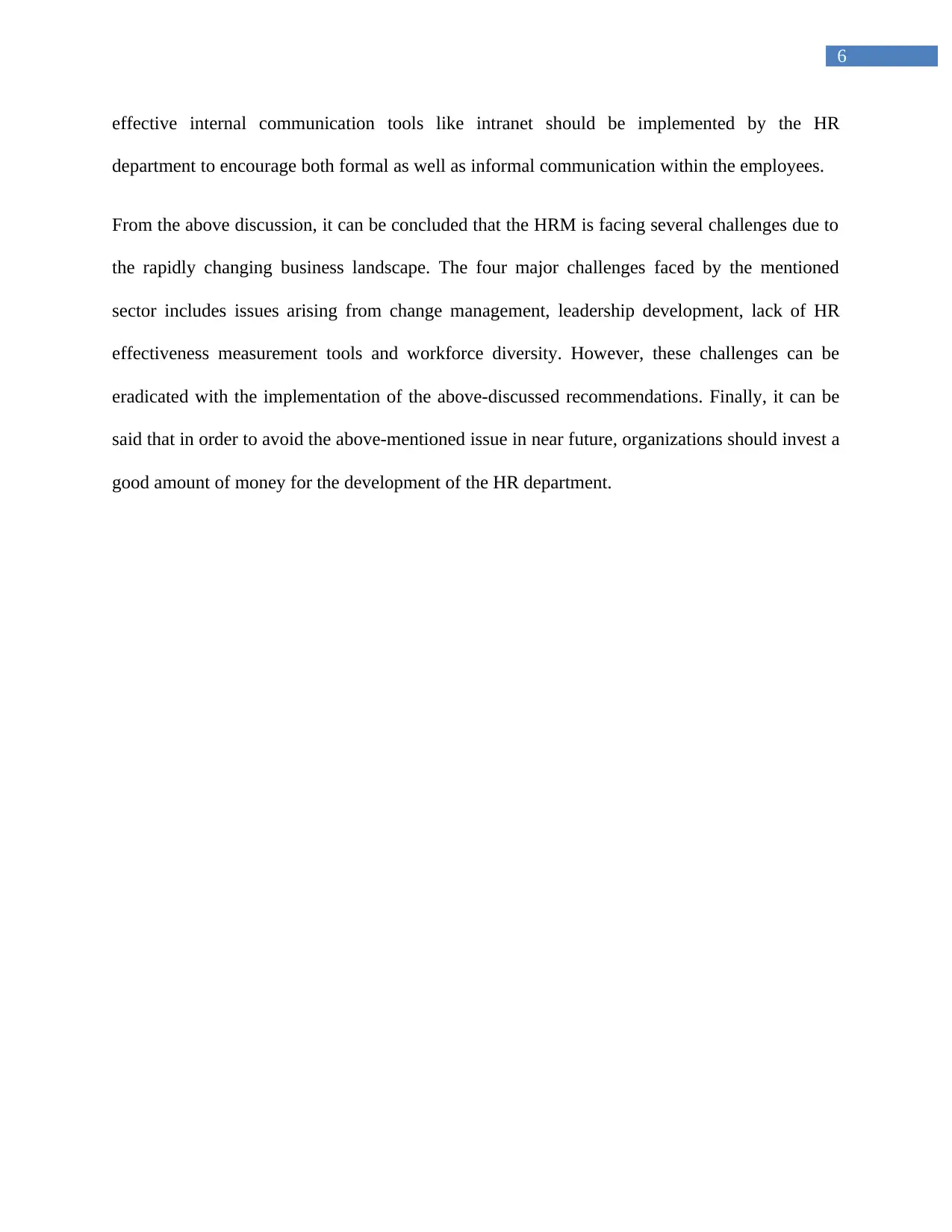
6
effective internal communication tools like intranet should be implemented by the HR
department to encourage both formal as well as informal communication within the employees.
From the above discussion, it can be concluded that the HRM is facing several challenges due to
the rapidly changing business landscape. The four major challenges faced by the mentioned
sector includes issues arising from change management, leadership development, lack of HR
effectiveness measurement tools and workforce diversity. However, these challenges can be
eradicated with the implementation of the above-discussed recommendations. Finally, it can be
said that in order to avoid the above-mentioned issue in near future, organizations should invest a
good amount of money for the development of the HR department.
effective internal communication tools like intranet should be implemented by the HR
department to encourage both formal as well as informal communication within the employees.
From the above discussion, it can be concluded that the HRM is facing several challenges due to
the rapidly changing business landscape. The four major challenges faced by the mentioned
sector includes issues arising from change management, leadership development, lack of HR
effectiveness measurement tools and workforce diversity. However, these challenges can be
eradicated with the implementation of the above-discussed recommendations. Finally, it can be
said that in order to avoid the above-mentioned issue in near future, organizations should invest a
good amount of money for the development of the HR department.
Paraphrase This Document
Need a fresh take? Get an instant paraphrase of this document with our AI Paraphraser
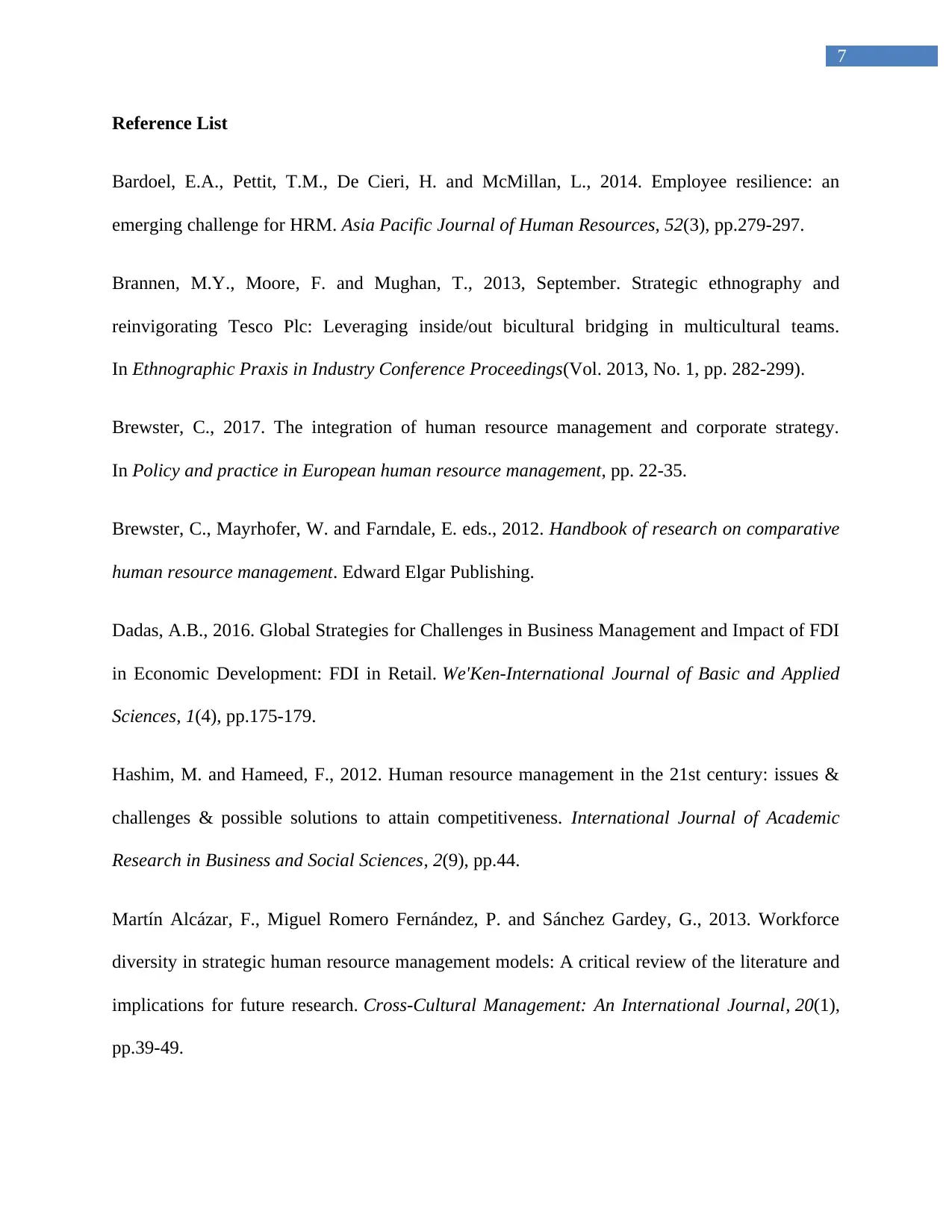
7
Reference List
Bardoel, E.A., Pettit, T.M., De Cieri, H. and McMillan, L., 2014. Employee resilience: an
emerging challenge for HRM. Asia Pacific Journal of Human Resources, 52(3), pp.279-297.
Brannen, M.Y., Moore, F. and Mughan, T., 2013, September. Strategic ethnography and
reinvigorating Tesco Plc: Leveraging inside/out bicultural bridging in multicultural teams.
In Ethnographic Praxis in Industry Conference Proceedings(Vol. 2013, No. 1, pp. 282-299).
Brewster, C., 2017. The integration of human resource management and corporate strategy.
In Policy and practice in European human resource management, pp. 22-35.
Brewster, C., Mayrhofer, W. and Farndale, E. eds., 2012. Handbook of research on comparative
human resource management. Edward Elgar Publishing.
Dadas, A.B., 2016. Global Strategies for Challenges in Business Management and Impact of FDI
in Economic Development: FDI in Retail. We'Ken-International Journal of Basic and Applied
Sciences, 1(4), pp.175-179.
Hashim, M. and Hameed, F., 2012. Human resource management in the 21st century: issues &
challenges & possible solutions to attain competitiveness. International Journal of Academic
Research in Business and Social Sciences, 2(9), pp.44.
Martín Alcázar, F., Miguel Romero Fernández, P. and Sánchez Gardey, G., 2013. Workforce
diversity in strategic human resource management models: A critical review of the literature and
implications for future research. Cross-Cultural Management: An International Journal, 20(1),
pp.39-49.
Reference List
Bardoel, E.A., Pettit, T.M., De Cieri, H. and McMillan, L., 2014. Employee resilience: an
emerging challenge for HRM. Asia Pacific Journal of Human Resources, 52(3), pp.279-297.
Brannen, M.Y., Moore, F. and Mughan, T., 2013, September. Strategic ethnography and
reinvigorating Tesco Plc: Leveraging inside/out bicultural bridging in multicultural teams.
In Ethnographic Praxis in Industry Conference Proceedings(Vol. 2013, No. 1, pp. 282-299).
Brewster, C., 2017. The integration of human resource management and corporate strategy.
In Policy and practice in European human resource management, pp. 22-35.
Brewster, C., Mayrhofer, W. and Farndale, E. eds., 2012. Handbook of research on comparative
human resource management. Edward Elgar Publishing.
Dadas, A.B., 2016. Global Strategies for Challenges in Business Management and Impact of FDI
in Economic Development: FDI in Retail. We'Ken-International Journal of Basic and Applied
Sciences, 1(4), pp.175-179.
Hashim, M. and Hameed, F., 2012. Human resource management in the 21st century: issues &
challenges & possible solutions to attain competitiveness. International Journal of Academic
Research in Business and Social Sciences, 2(9), pp.44.
Martín Alcázar, F., Miguel Romero Fernández, P. and Sánchez Gardey, G., 2013. Workforce
diversity in strategic human resource management models: A critical review of the literature and
implications for future research. Cross-Cultural Management: An International Journal, 20(1),
pp.39-49.
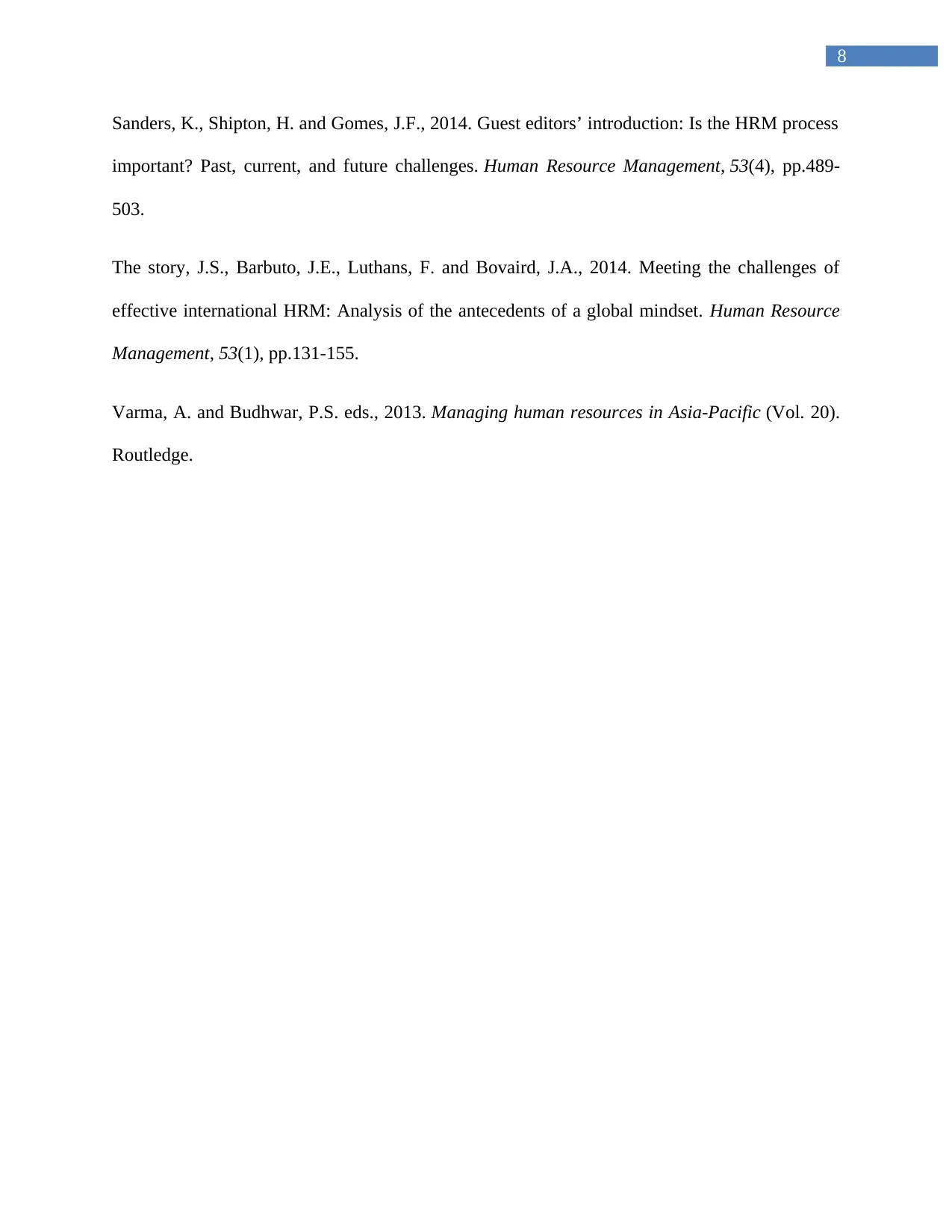
8
Sanders, K., Shipton, H. and Gomes, J.F., 2014. Guest editors’ introduction: Is the HRM process
important? Past, current, and future challenges. Human Resource Management, 53(4), pp.489-
503.
The story, J.S., Barbuto, J.E., Luthans, F. and Bovaird, J.A., 2014. Meeting the challenges of
effective international HRM: Analysis of the antecedents of a global mindset. Human Resource
Management, 53(1), pp.131-155.
Varma, A. and Budhwar, P.S. eds., 2013. Managing human resources in Asia-Pacific (Vol. 20).
Routledge.
Sanders, K., Shipton, H. and Gomes, J.F., 2014. Guest editors’ introduction: Is the HRM process
important? Past, current, and future challenges. Human Resource Management, 53(4), pp.489-
503.
The story, J.S., Barbuto, J.E., Luthans, F. and Bovaird, J.A., 2014. Meeting the challenges of
effective international HRM: Analysis of the antecedents of a global mindset. Human Resource
Management, 53(1), pp.131-155.
Varma, A. and Budhwar, P.S. eds., 2013. Managing human resources in Asia-Pacific (Vol. 20).
Routledge.
⊘ This is a preview!⊘
Do you want full access?
Subscribe today to unlock all pages.

Trusted by 1+ million students worldwide
1 out of 9
Related Documents
Your All-in-One AI-Powered Toolkit for Academic Success.
+13062052269
info@desklib.com
Available 24*7 on WhatsApp / Email
![[object Object]](/_next/static/media/star-bottom.7253800d.svg)
Unlock your academic potential
Copyright © 2020–2025 A2Z Services. All Rights Reserved. Developed and managed by ZUCOL.




